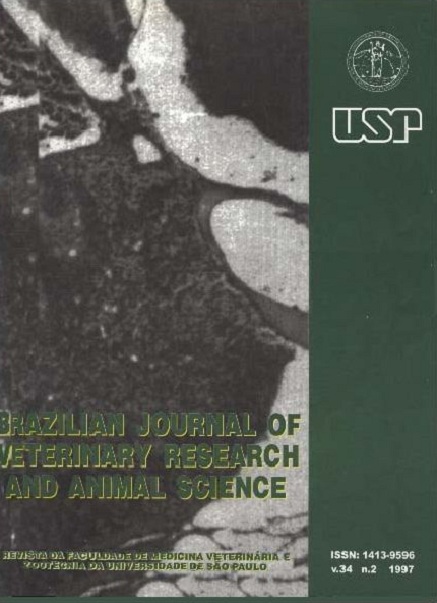“In situ” fiber degradability of sugar cane bagasse treated with alkaline solutions and protein degradability of cotton seed mal, with canulated steers
DOI:
https://doi.org/10.11606/issn.2318-3659.v34i2p73-77Keywords:
Digestibility, Cottonseed meal, Sugarcane bagasse, Alkaline, Solutions, BovineAbstract
Sugar cane bagasse (SCB) was immersed either in water (B), or in sodium hydroxide solution 2% (D), or in wood ashes solution 30% (C), or was supplemented with buffers in the concentrate mixture: (sodium bicarbonate, 1,1% and magnesium oxide 0,7% of ration dry matter (DM)), to evaluate this residue for ruminant feeding, receiving diets with 30% of DM as SCB. Four rumen canulated steers were used to estimate ruminal degradability rates of DM and neutral detergent fiber (NDF) of the SCB in situ, as well as DM and CP degradabilities of the cotton seed meal, using a 4 x 4 change-over design. Results showed higher DM degradabilities for SCB or treatment D, and also for NDF, but in 72 h and 96 h of incubatio times. Cotton seed meal presented similar rates of degradabilities among all treatments. Treatment D was efficient to improve SCB rumen degradability.Downloads
Download data is not yet available.
Downloads
Published
1997-04-01
Issue
Section
ANIMAL NUTRITION AND NUTRITIONAL DISEASES
License
The journal content is authorized under the Creative Commons BY-NC-SA license (summary of the license: https://
How to Cite
1.
Sonksen S, Lucci C de S, Melotti L. “In situ” fiber degradability of sugar cane bagasse treated with alkaline solutions and protein degradability of cotton seed mal, with canulated steers. Braz. J. Vet. Res. Anim. Sci. [Internet]. 1997 Apr. 1 [cited 2024 Apr. 16];34(2):73-7. Available from: https://www.revistas.usp.br/bjvras/article/view/50247





